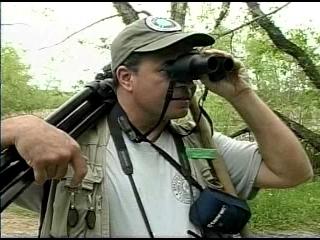
----------------------------------











When the heron had finished, I went back to look at the gator by
nest#5 and talk to more visitors. Some alligators talked to each
other, shown on this
page.
I remained in the
area until 11 or so, when I left to go visit Live Oak trail to check
on Apple Snail incursion (more on that, at another time, or check this page).
03/12/2017 The morning
was a bit cool at BBSP today. I was up on the Observation
Tower at 40 Acre Lake when I started watching a Great Blue
Heron that was down in Pilant Lake. I saw the
heron catch a Lesser Siren, and I tried for some
long-distance shots with the camera. I also shot some video.
Then I hurried down to the ground, and I was able to get
closer to the heron as it
subdued and ate the siren. I've seen events like this on
other occasions, and a few of these other examples show on
this page.
Below are some images that I shot as photos and some
frame-grabs from the video I filmed. The small front legs of
the siren show well in some of the images. The video
can be found by following this link(mp4).
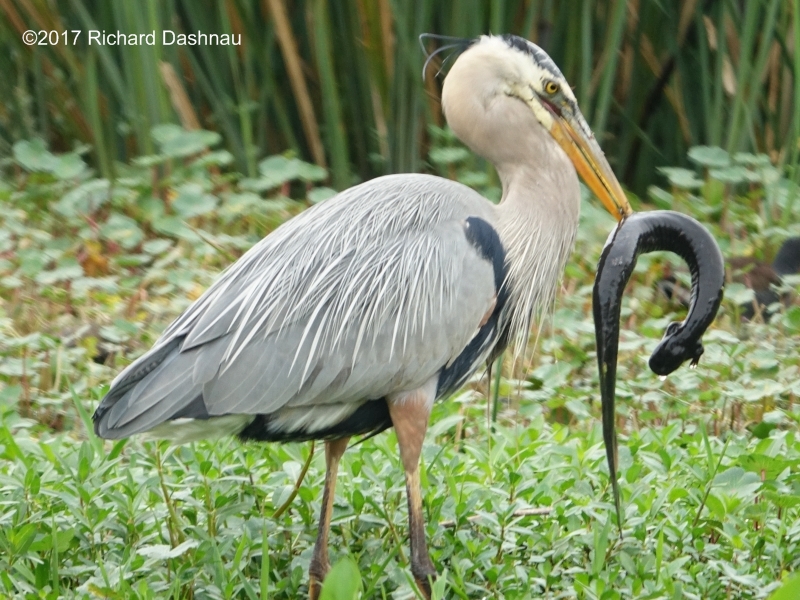
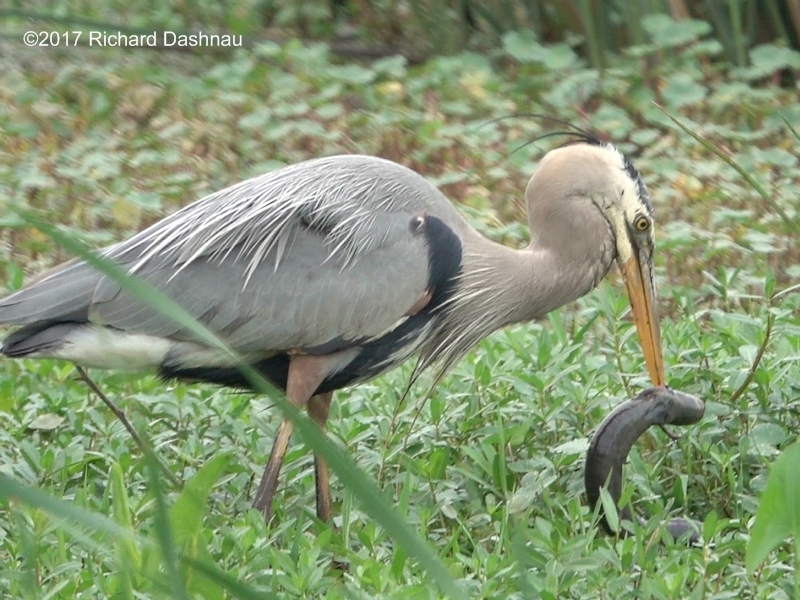
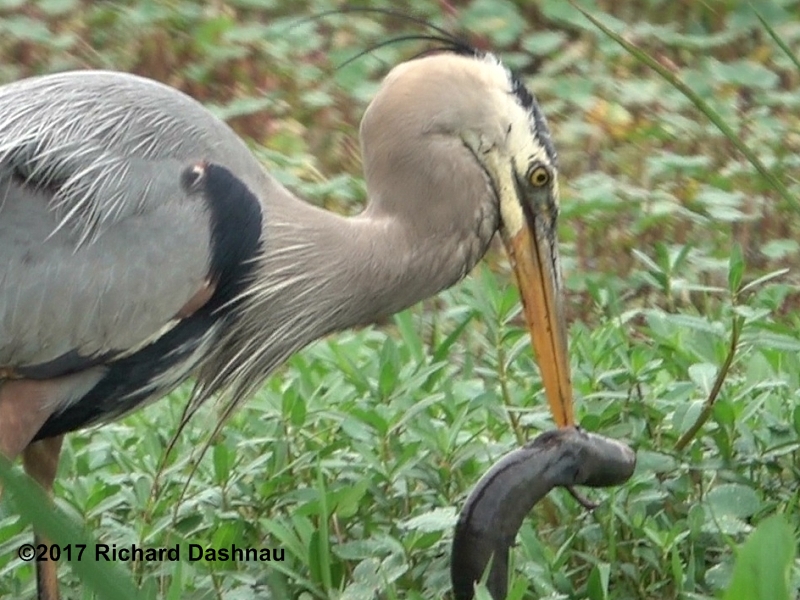
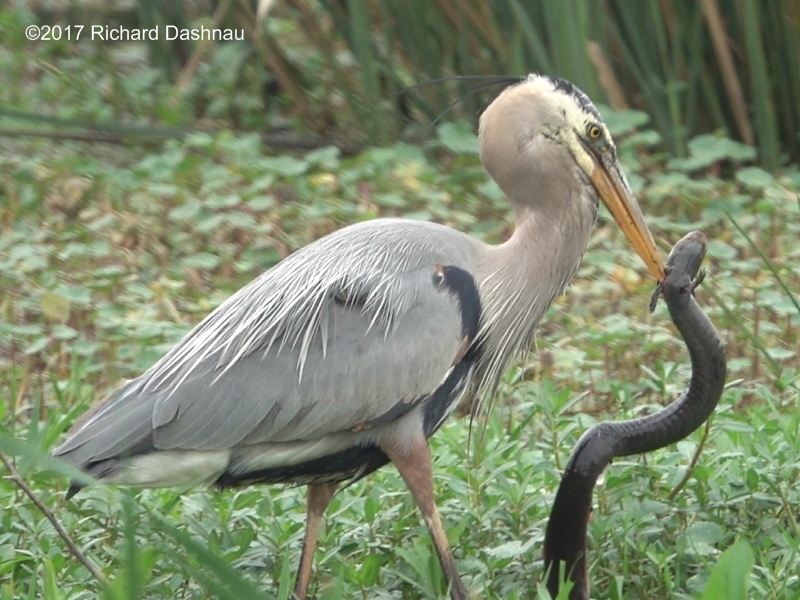
9/18/2016 I was watching a Great Blue Heron
as it squatted on the concrete casing of the floodgate between 40
Acre Lake and Pilant Lake. It would "squat"-intently watching the
water-then
stand as whatever it wanted to catch moved away. Finally, it
squatted, stabbed, and....came up with a Plecostomus! These
are one of many species of "armored catfish". I caught
some
high-speed video as it snatched the fish, and watched the Heron
for 25 minutes as it worked at getting the fish into a position to
eat.I filmed and took photos during that time--until a park
visitor
on a bicycle scared off the heron. The images below are
photos that I took between video clips. The edited version of
those clips can be seen here(mp4).
I have photos and video of a Great
Blue Heron eating a plecostomus at an earlier time further down
this page. This time, I watched as the Heron worked around
the challenge of eating this armored prey. The video shows
how
the Heron seemed to test the hardness of the pleco, and also
manipulated the fish to expose its softer belly. In other video
clips on this page , Herons demonstrate the usual technique of
swiftly
ramming the massive, sharp beak into the prey until it stops
moving. With the Plecostomus, I only saw one such stab. The Heron
did a lot of "probing" with the tips of its bill, and then made
short,
powerful thrusts. The Heron did finally succeed in impaling the
pleco.
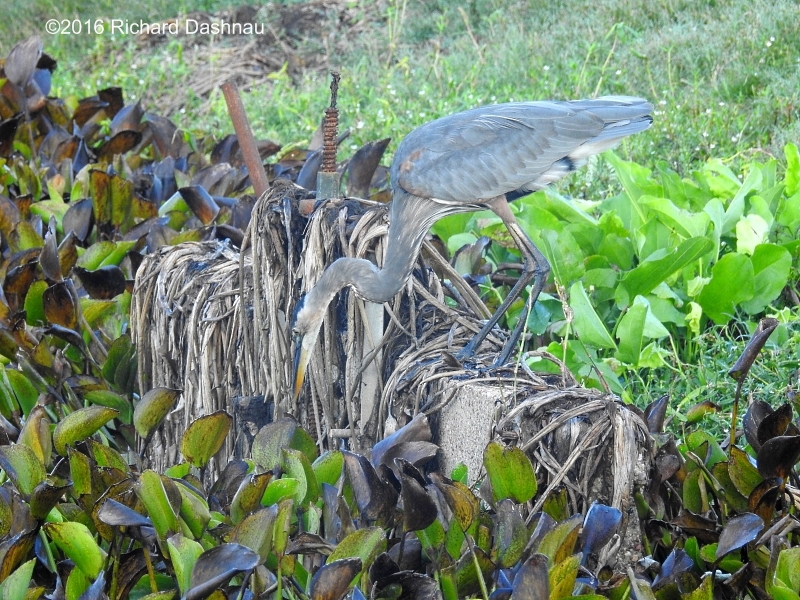
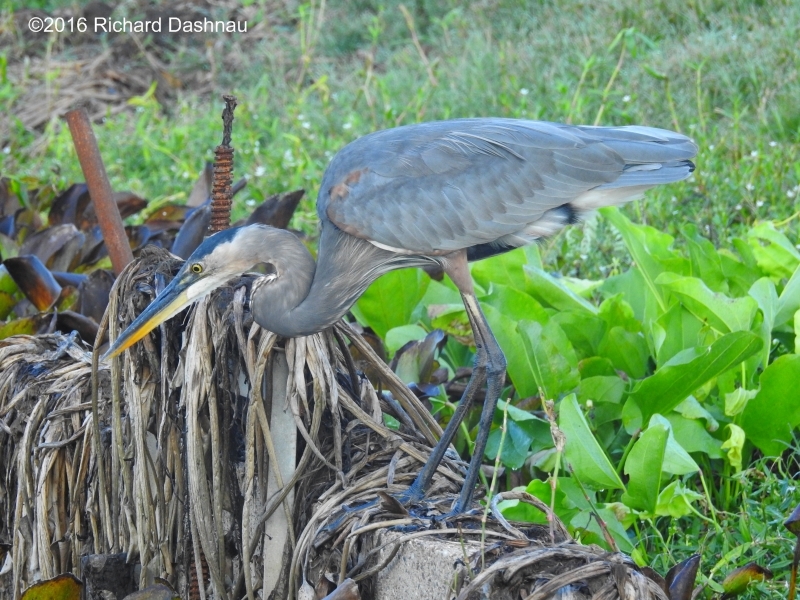
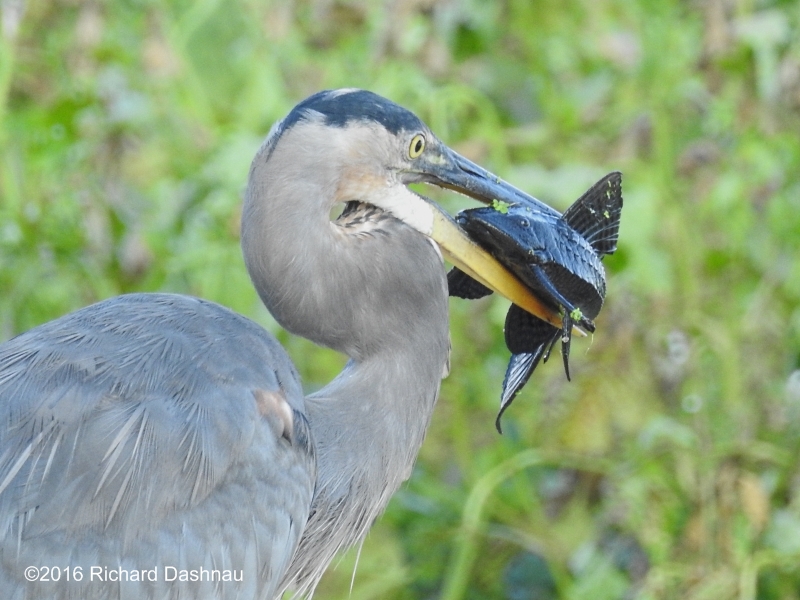

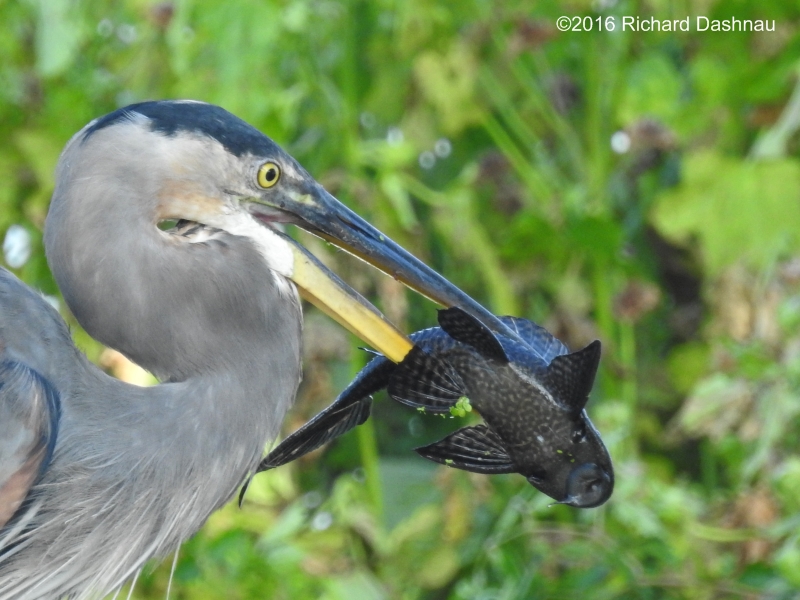
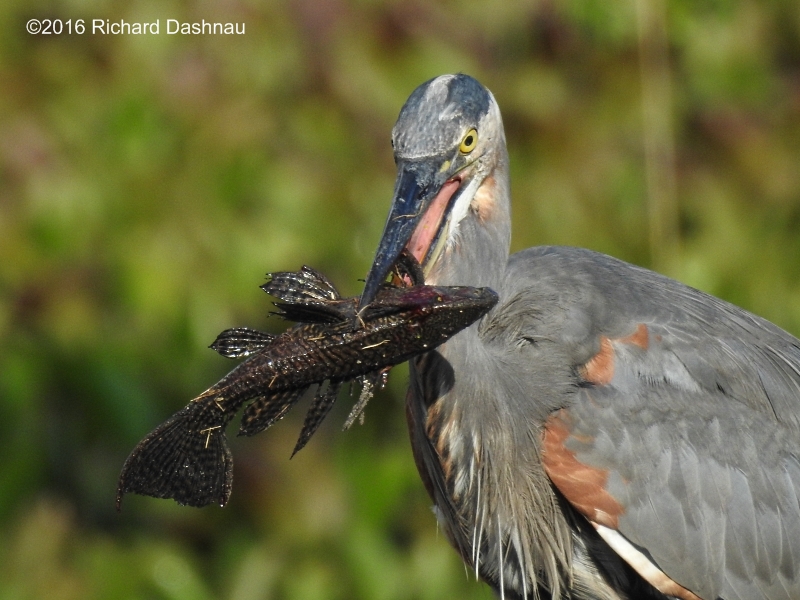

The first few times I
searched the internet for information on Plecostomus and their
environmental impact, I hadn't found much. Since then, I found
some more information.
First, I have found that armored catfish can
get oxygen directly from the air, but they don't use a lung, or
swim bladder. Instead, it appears that they can extract oxygen
from air gulped into their
stomach!
Here's one study (at least the abstract):
"Morphology of the air-breathing stomach of the catfish Hypostomus
plecostomus." Podkowa D1, Goniakowska-Witalińska L. (link is here)
Arrmored Catfish are interesting and amazing. Unfortunately, they
are invaders in the Texas ecosystem, and can cause damage. They
are pushing out native species of fish, and are also
causing physical changes to the environment by their nesting
habits. This article published 9/15/2016 in the Houston
Chronicle describes damage done by plecos and other invasive
species
(tilapia, grass carp) click this link. So, cheer for this
determined Heron; because he's helping save our environment!
01/31/2016 Oh no...another invader at the park.
Through the entire month of June, in 2015, a large part of Brazos
Bend State park was under water. This water came from the Brazos
River and Big Creek. Animal and plant life from the rivers
also
entered the park. For example, tilapia were seen in the park
right after the water receded. During the months of August,
September and October of the same year (2015) I noticed many fish
hitting the
surface of the water-mostly along the Spillway Trail. The
surfacing fish were numerous, but so quick that I could not tell
what they were. So I spent a few weekends trying to shoot
high-frame rate video so
that I could slow the action down. When I went through my
samples, I found mostly what I expected. Most of the fish were
bowfin or gar (short-nose or spotted gar). But...in a few of the
video clips I saw a
different fish-and it appeared to be a type of plecostomus. I've
got more details with links to the video clips on my web page here.
It was a bit frustrating then because the video wasn't very
clear. I talked
with David about this during that summer, and he recalled seeing
carcasses of plecostomus after one of our park dry spells in
the past. And then....
Last Sunday, I witnessed more proof that Plecostomus are certainly
in the park, but this time I caught much better imagery. At about
9am I was on the Spillway Trail, just East of the Observation
Tower,
when I noticed a Great Blue Heron about 50 yards away on Pilant
Lake. It was eating something dark, and at first I thought it was
a Lesser Siren. But when I looked through binoculars I saw that it
was
eating a large Plecostomus! So I started shooting, and
watched as the Heron finally swallowed the armored fish. So, here
are some images...some are photos, and some are frame grabs from
the video
clips. I've edited the clips together into this film(mp4).
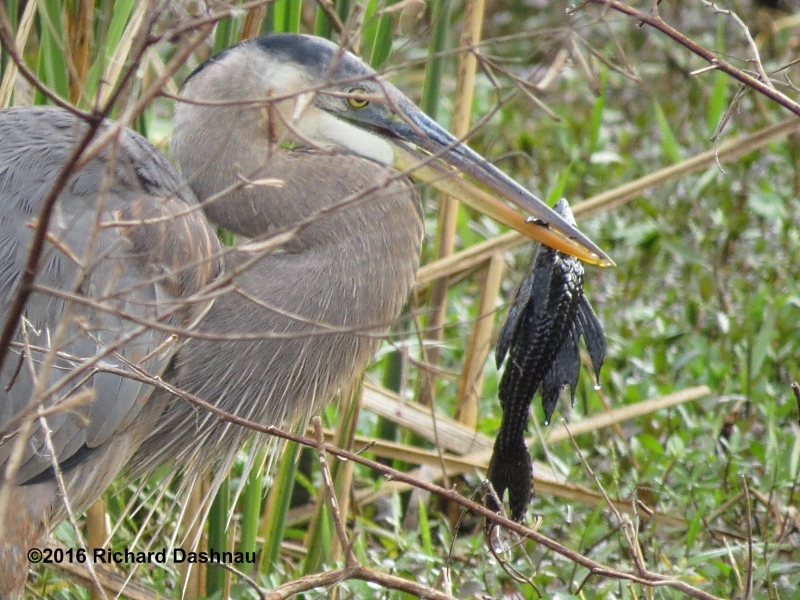

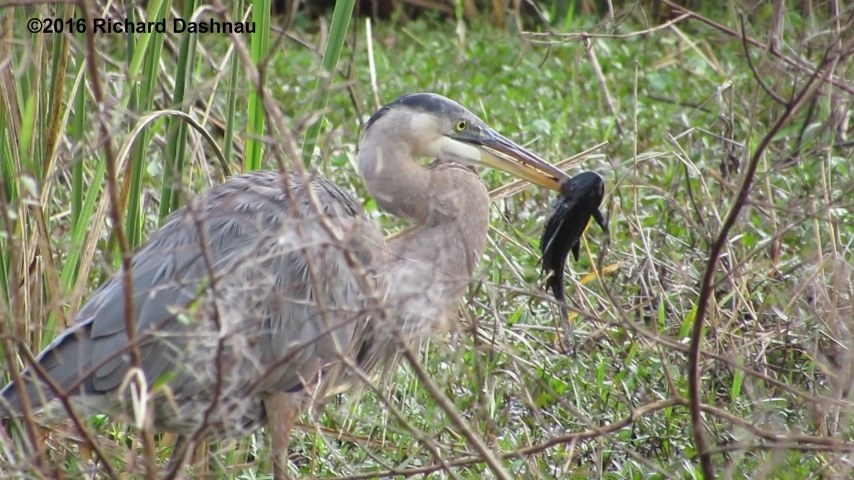
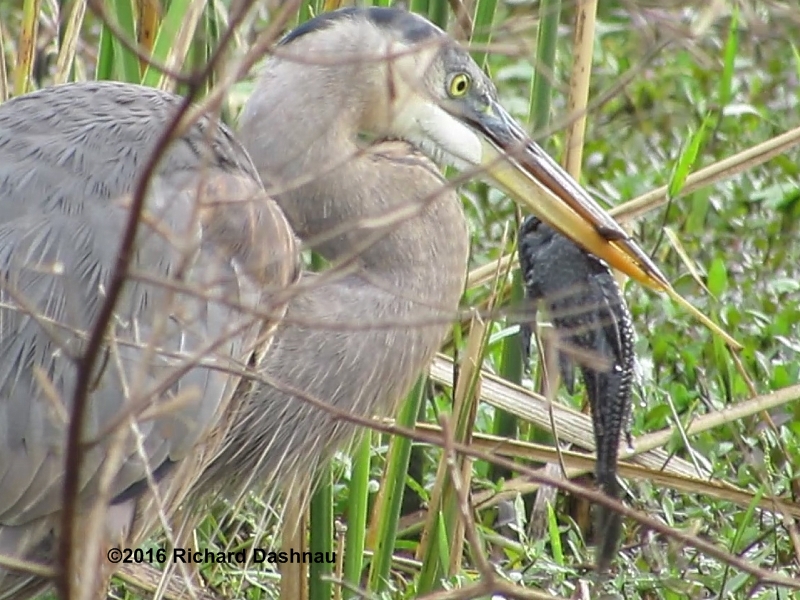
Later that
day, I talked to David about this, and he had also seen proof
of plecos...he told me he'd recently seen the heads of 2
carcasses on the Elm Lake trail. And now I wonder which
of predators could
have caught the 2 fish and left
the heads behind. Herons would not have left anything.
Alligators probably wouldn't have left *2* heads either. Could
Otters be the culprit? According
to
various web sources
"plecostomus" has become a sort of generic term for a few
similar species of fish. They are invasive in Texas. Common
Names include "Armored Catfish", "Suckermouth Catfish", and
Algae Eaters.
Information
on
their Texas status is here:
http://texasinvasives.org/animal_database/detail.php?symbol=9
and
here:
http://www.nature.org/ourinitiatives/regions/northamerica/unitedstates/texas/newsroom/texas-by-nature-armored-catfish.xml
02/07/2010 Across Pilant Lake from the
Observation Tower (actually near the center of the lake), Great
Blue Herons built nests in the trees. From time to time, the
Herons will hunt
for food near enough to see what they're doing. This morning, one
of them landed close enough for me to get a good view it with my
camera. I caught a series of nice clips (shot at
210 fps) of it landing, eating, and taking off. I've edited some
of this together into a short movie clip. Below are some image
captures from the footage. And here's a link to the
video
clip
shot at high speed (mp4)
 --
-- ---
--- -----
----- 
COMING
IN FOR A LANDING
WRESTLING
WITH A SIREN
WRESTLING WITH A SIREN
TAKING OFF
WITH STICK
The animal the Heron caught is not an eel, and
not a snake. It is an amphibian. This is a Lesser Siren (Siren
intermedia). Sirens are in the order Caudata--the
Salamanders. Sirens
are nocturnal. They eat small fish, tadpoles, insects, and other
invertebrates. They range in size from 7 inches to 27 inches long.
Sirens are distinctive when seen closely. They have
two short legs with feet that have 4 toes (So, could one
could say that they are a two-foot animal with two feet?).
Sirens also have external, branched gills. They are nocturnal and
live
in water. However, if that water dries, they can secret a mucus
covering which will allow them to survive while buried in the
dried mud. This "suspended animation" is called "estivation".
I can't find out how long a siren can estivate and still survive.
Sirens feed by sucking food into their mouth. They don't have wide
jaws like a frog or most salamnders; but a narrow
mouth that can extend quickly and form a suction. I've seen this
in action, and the movement is very fast. The food is there,
just in front of the Siren's nose, and then there's a quick
movement, and the Siren is chewing something. Below are two
images cropped from the same photograph showing the Siren a little
better.
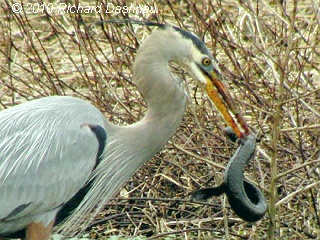 ----
---- 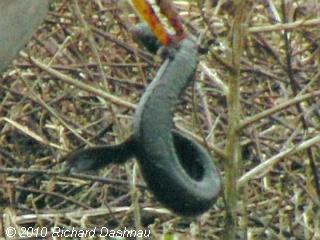 ----
---- 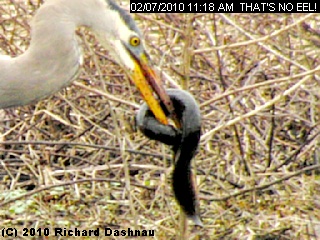
DIFFICULT
WITH NO
HANDS
THE
SIREN
RICKUBISCAM SHOT
Here's the taxonomic rank of the Lesser Siren:
Kingdom Animalia
Phylum Chordata
Subphylum
Vertebrata
Class
Amphibia
Order
Caudata
Family
Sirenidae
Genus
Siren
Species
Siren
intermedia
 -
-
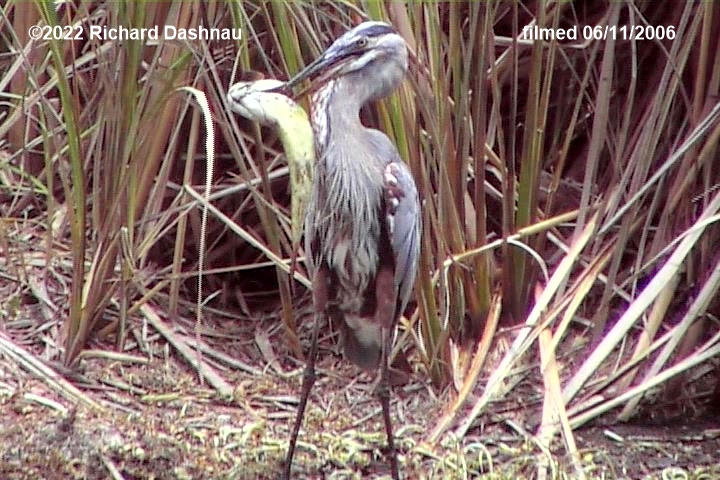 -
-
ONE
TWO
THREE
FOUR
The Great Blue Heron dropped the bowfin, and to my amazement,
the bowfin was still very much alive! I was trying to take
still photos while
the camcorder was filming, so
the fish flopped
almost out of view. The Heron stabbed it again, and then neatly
swallowed the fish. The video clip is
here(mp4). (see THREE and FOUR above, and FIVE through SEVEN,
below).
- -
-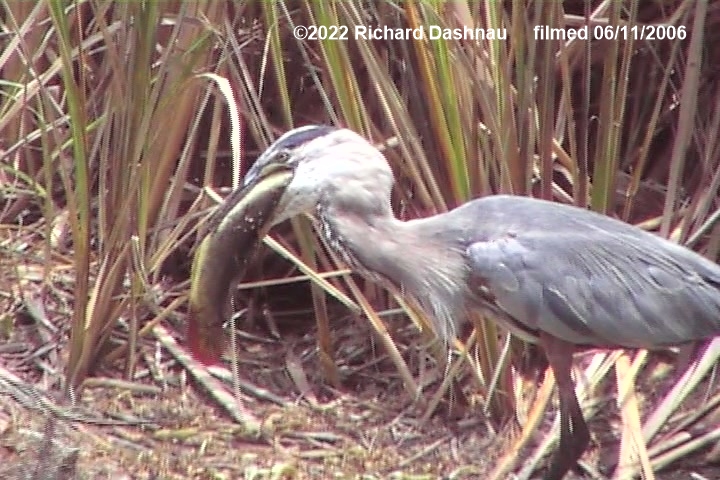
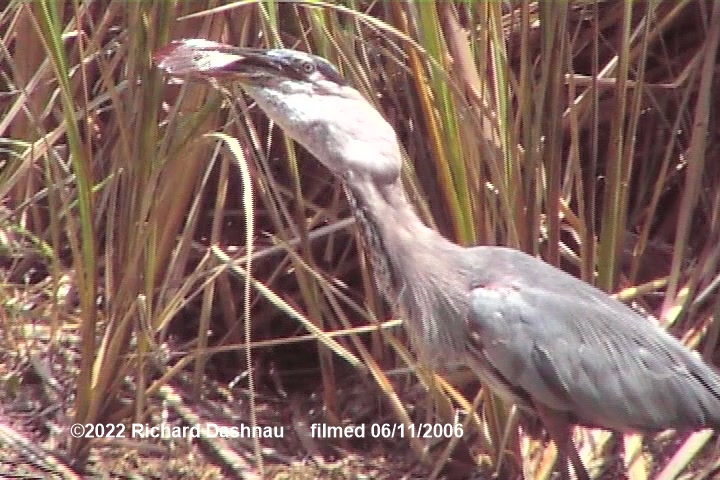 -
-
FIVE
SIX
SEVEN
EIGHT
------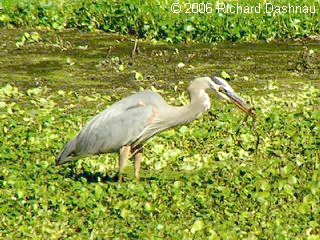 ---------------
---------------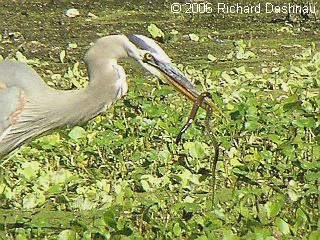 ----
----
SUCCESSFUL
HUNT
BETTER
CLOSEUP VIEW
3/05/2006--(update
added 01/08/2017) I
was on the West loop of Elm Lake trail when I saw a Great Blue
Heron on one of the islands. It appeared to be stalking something,
so I set up the video camera I had at the time.
When the heron caught its prey, I started filming. I thought it
had caught a fish. But when I zoomed in with the video camera, I
could see that the Heron had caught a baby alligator! While I was
filming, I noticed an adult
alligator moving towards the Heron, which flew off long before the
alligator could reach it. In the 10 years since I shot this video
clip, I've never had a chance to witness another Great Blue Heron
with a baby alligator--although
others have. Alligator nests at Brazos Bend State park average
about 33 eggs per nest. If all those eggs hatch, only
one will possibly survive the 3 years after it hatched. Most of
the losses are probably due to predation by
the many wading birds at the park; like this Great Blue Heron. The
two images below are frames from the video clip I shot, and the
clip can be seen at this
link(wmv).
------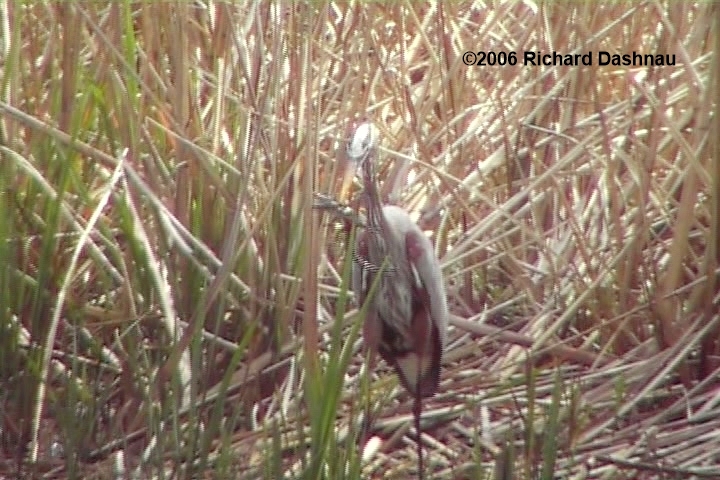 ---------------
---------------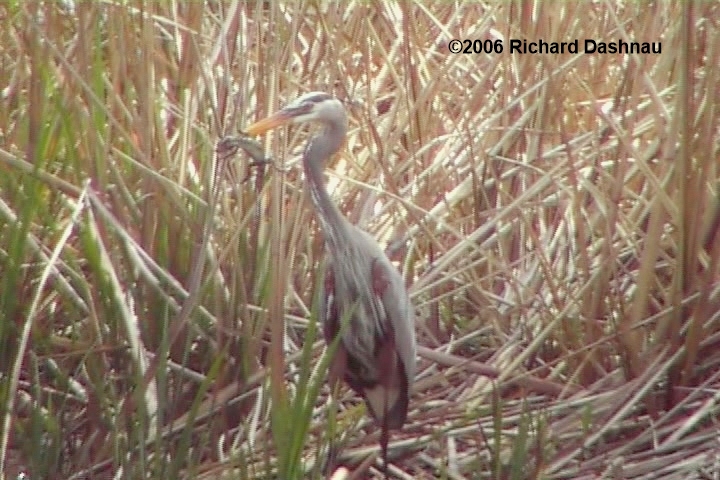 ----
----
BLUE
HERON WITH BABY ALLIGATOR 1
BLUE
HERON WITH BABY ALLIGATOR 2
January 18, 2004Okay, so we got a
little cool weather today. No big deal. Not when compared to
the below-zero (F!) temperatures that have been reported in the
Northeast US this week! So, the temperature stayed under
45 degrees, or at least it felt that way at Brazos Bend State
Park. We'd gotten about 3 inches of rain recently, so water was
high, and it was flowing nicely over the spillway between Pilant
Lake and Pilant Slough. If the weather
had been a bit warmer (perhaps mid-sixties with lots of sun),
alligators would have been there, looking for fish being swept
through the spillway. The alligators didn't show, but quite a few
of our wading birds did. The last
image below (GREAT BLUE) is a nice close-up shot of a Great Blue
Heron. When I first saw this heron, it was perched on the
rail of the Spillway Bridge (see TOLL, ONE FISH, below)
--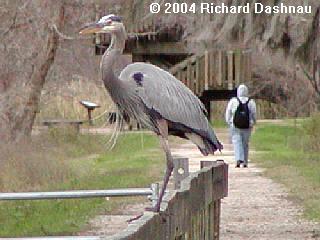 ----------
----------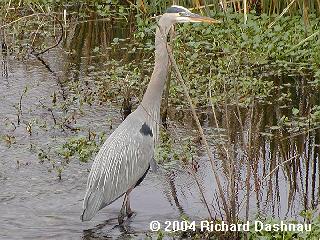 ----------
----------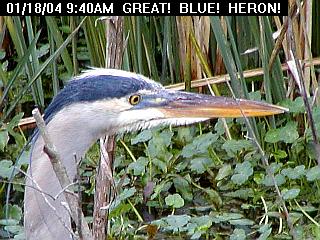
PAY TOLL--ONE
FISH
WATER'S FINE!
GREAT
BLUE
The person in the picture
is quite a bit further down the trail, and is only that small in
perspective. It's a Great Blue Heron, not a Humongous
Blue Heron, after all. Then, it jumped into the water, and walked
under the bridge
and I used the opportunity to sneak up closer and catch it
standing (see WATER'S FINE!, above). It's always impressive
to see these birds take flight from nearby. They are BIG.
See a bird of this size perched on the bridge
handrail was an arresting sight by itself, but seeing it open its
wings and flap from about thirty feet away can make you hold your
breath for a second. It just seems so odd to see a bird so
large standing on anything but the
ground. Visitor
attendance at the park was slow, and it was a pleasure to be
outside at the silent park watching the wading birds fishing (a
lot of them seemed to be eating crawfish).
Click here for Great Blue Herons Page 2.
If you'd like to know more about the park follow these links:
Brazos Bend State Park The main page.
Brazos
Bend
State Park Volunteer's Page The
volunteer's
main page.
Go
back to my home page, Welcome to
rickubis.com
Go back to the RICKUBISCAM
page.
Go back to the See
the World page.